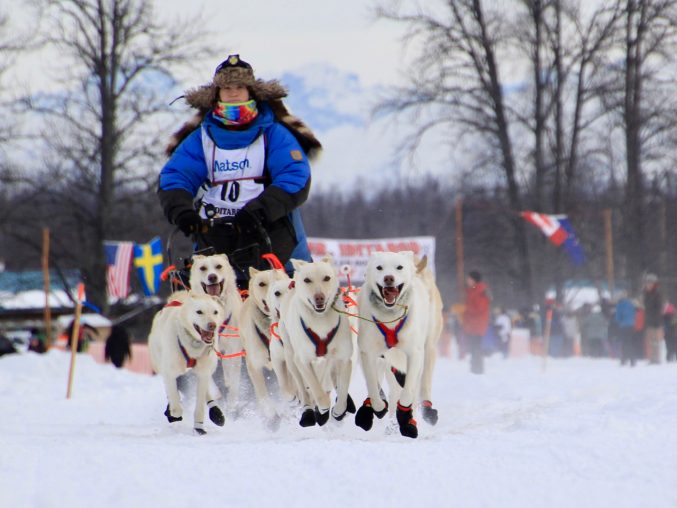Today I had the privilege of speaking to students at Knik Charter School and Big Lake Elementary about the Iditarod and about sled dogs. Students were from all grade levels from Kindergarten to 7th grade, and they had various levels of knowledge about sled dogs. My question to them, and to you, is: What makes a good sled dog?
When students first come into my classroom, they might say to me, wow, you really love dogs! Sled dog posters and images are everywhere, all tied to core values and classroom expectations. Many of my students, as I’m sure yours do, have dogs as pets. Almost all the hands went up when I asked students that question today. As the year progresses, my students and I engage in lots of conversations comparing their pet dogs to sled dogs–what’s the same, and what’s different. My presentation to Alaska school students developed out of these conversations.
So before the 150-mile Jr. Iditarod starts this weekend and the 975-mile northern route Iditarod starts the next, I wanted to share information about what makes a good sled dog. I also want to suggest ways you can engage your students in this learning. This is the first of three posts on this topic.
Alaskan huskies are a composite breed of dog specially bred for sled dog racing, both short and long distances. Over the decades, mushers and their families have developed strong lines of dogs that overcome the challenges of the Iditarod with ease. Alaskan huskies have certain traits that make them highly suited for long-distance racing.
It may seem obvious, but the number one characteristic racing sled dogs must have is a joy for running. Many authors describe the dogs as “born to pull,” which is the title of Bob Carey’s amazing book about sled dogs. In this photograph of Calvin Dougherty and his dogs in the Jr. Iditarod, you can see the joy and smiles on the dogs’ faces as they run together. They are clearly having the time of their lives. Sled dogs exhibit this joy as puppies and the drive to run is cultivated through many months of training full of camaraderie and exuberance.

The Ultimate Athletes Driven by Jr. Iditarod Musher, Calvin Daugherty. Photo: Terrie Hanke
Speed and endurance are twin characteristics that Alaskan husky sled dogs must have. Iditarod dogs should be strong and determined enough to run for miles without getting tired. I shared this photo of the dog Blue Steel and his companions with students, and they were struck by his determined blue eyes. I love this image because the dogs are all showing confidence and perseverance, especially Blue Steel, the leader. The average speed of Iditarod dogs throughout the race is 8 miles an hour, which may not seem very fast, but the dogs can maintain this pace throughout the nearly 1000-mile race.

Monica Zappa’s dog Blue Steel and his companions, showing Endurance. Photo: Terrie Hanke
What powers all this speed, endurance, and drive to run? A voracious appetite! Iditarod sled dogs must be able to consume enough calories (about 10-12,000 per day) to fuel their bodies. Food consists of high-protein kibble, along with salmon, turkey, chicken, beef, and even pure fat. Water is mixed in with this food to provide adequate hydration. I showed students this photo of Deke Naaktgeboren’s dogs snacking on salmon slices after the 2023 Ceremonial Start. As I watched him throw down the frozen pieces, each dog waited his or her turn for their well-deserved snack, then gobbled it up!

Chowing down on salmon snacks after the 2023 Ceremonial Start. Photo: K. Newmyer
In order to get the middle-grade students thinking about how their dogs are similar and different to Iditarod sled dogs, I named the feature, then showed an image where you could clearly see the characteristic. I then asked students, “What do you notice?” We talked about how we could see in the photograph of the sled dog the unique characteristic. Asking students to “notice” is a great technique to generate thinking. It allows for open-ended responses that you can never say “no” to. Students feel safe sharing their ideas, because it’s very likely that someone else noticed it too. Often in my class, I see the sign-language sign for “agree” being given when students hear something they also noticed.
Humor is also a great learning tool, because it develops a safe environment like open-ended “noticing.” After discussing the image and the characteristic, I shared an image of a dog that clearly did not have that feature! I think the middle-grade students especially enjoyed the comparisons to the dogs below–and giggling a little bit helped them remember that sled dogs like to run far and eat lots of food. These are all beloved pet dogs belonging to my friends and family.
- Archie and Dahlia prefer to go to the library instead of run. Photo: MM
- Teddy loves to run, but he can only last for ten minutes. Photo: NS
- Samwise lives in Mexico and likes to eat flowers. Photo: ED
I hope you will engage your students in learning more about amazing Alaskan husky sled dogs through noticing and humor. Stay tuned for Part 2 of this post tomorrow. Questions? Email me at emailtheteacher@iditarod.com.





